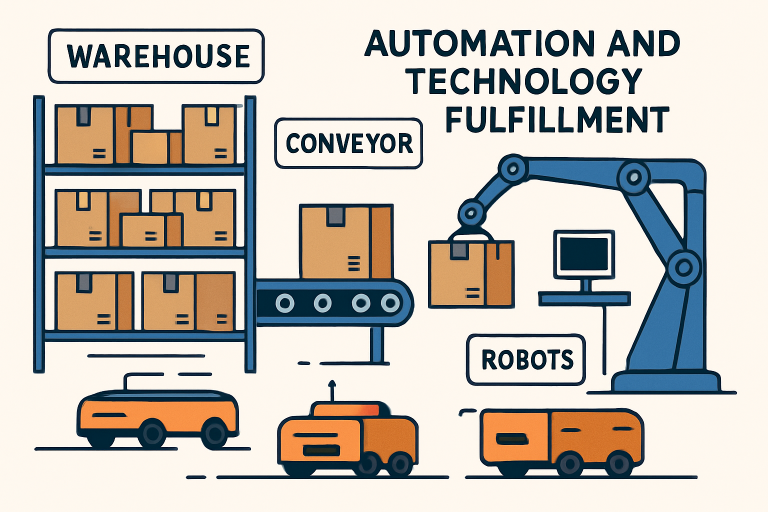Key Takeaways:
- Automation and robotics are revolutionizing warehouse operations, enhancing efficiency and accuracy.
- Sustainable practices in packaging and logistics are becoming essential to meet consumer expectations.
- Omnichannel fulfillment strategies are crucial for providing seamless customer experiences across various platforms.
- Advanced technologies like AI and IoT are optimizing inventory management and demand forecasting.
E-commerce is evolving rapidly, with order fulfillment becoming a critical focus for brands seeking to meet rising consumer demands for efficiency, speed, and sustainability. Adapting innovative technologies and strategies in ecommerce fulfillment allows businesses to remain responsive in a competitive environment. With the growth of online shopping, fulfillment trends directly impact customer satisfaction and loyalty.
Companies are investing in intelligent warehousing, greener processes, and omnichannel integration to optimize the entire order flow, from click to doorstep. Keeping up with these trends is no longer optional—it’s essential for survival in today’s retail climate. Whether you’re an emerging startup or a seasoned e-commerce merchant, understanding and leveraging these trends can streamline your operations and drive long-term success.
Automation and Robotics in Warehousing
Automation and robotics are fundamentally transforming how warehouses manage orders and inventory. Today’s advanced fulfillment centers deploy automated picking systems, conveyor belts, and mobile robots to execute repetitive and physically demanding tasks. The deployment of intelligent robotics reduces errors, accelerates processing times, and minimizes labor costs, all of which contribute to building a competitive advantage. Major retailers like JD.com have pioneered data-driven approaches by integrating smart robots with supply chain analytics to optimize order sorting and delivery, setting a new industry benchmark. These advances free up human workers to focus on higher-value activities such as exception handling and customer care.

Sustainable Fulfillment Practices
Sustainability has moved from a nice-to-have to a mission-critical as consumers become more environmentally conscious. E-commerce brands are rethinking packaging by investing in materials that can be recycled or composted, reducing waste at the source. Route optimization tools enable shippers to minimize logistics-related emissions and implement greener last-mile delivery solutions—from electric vehicles to bicycle couriers. Efforts to optimize warehouse lighting and employ renewable energy are gaining traction, further curbing the carbon footprint of fulfillment operations.
Omnichannel Fulfillment Strategies
Integrating inventory, order management, and logistics across all sales platforms is now essential. Omnichannel strategies ensure customers receive consistent service whether they shop via desktop, mobile, or social media. Real-time inventory visibility across all distribution points reduces overselling, enhances fulfillment speed, and ensures better stock allocation to meet online and in-store demand. Tools that unify point-of-sale data with backend fulfillment, like ship-from-store models, empower merchants to turn physical stores into miniature distribution centers, driving greater efficiency and geographic reach.
AI and IoT in Inventory Management
Artificial intelligence and the Internet of Things are reshaping inventory management. AI-driven analytics forecast demand patterns, preventing stockouts and overstocks by analyzing sales history, promotions, and third-party data like weather trends. RFID tags, IoT sensors, and smart shelves provide real-time inventory tracking, reducing shrinkage and errors. This comprehensive visibility supports proactive replenishment, improving fulfillment rates and eliminating excess storage costs. As these systems become more integrated, companies can adapt rapidly to fluctuations in supply and demand, maintaining high service levels.
Personalized Packaging and Customer Experience
Packaging is an increasingly vital touchpoint in the e-commerce journey. Customized packaging creates memorable unboxing experiences, featuring branding elements, customer names, and personal notes or samples. This approach enhances customer engagement and encourages repeat purchases. Eco-friendly packaging options further communicate brand values to environmentally sensitive shoppers, while data-driven customization lets brands tailor the presentation to the recipient’s preferences. These finishing touches build loyalty and set brands apart in a competitive landscape.
Reverse Logistics and Returns Management
Return policies can make or break customer trust. A seamless, transparent process—from automated return labels to quick refunds—reduces friction and fosters loyalty. E-commerce businesses invest in self-service return portals, dedicated returns centers, and intelligent analytics to spot patterns in product defects or sizing issues. A robust returns operation enhances customer satisfaction and identifies opportunities for process improvements and tighter inventory control.
Hyperlocal Fulfillment and Micro-Fulfillment Centers
To cater to growing expectations for same-day and next-day delivery, brands invest in micro-fulfillment centers (MFCs) in urban areas. These smaller, highly automated hubs are equipped to manage high-order volumes in densely populated locations, placing products closer to end-consumers. MFCs leverage technology to quickly pick and pack orders, drastically reducing the delivery window and improving the shopping experience.
Subscription-Based E-Commerce Growth
The explosion of subscription models in e-commerce presents distinct fulfillment challenges—demanding highly precise inventory forecasting and on-schedule replenishments. Efficient recurring delivery of personalized products builds predictable revenue streams and customer affinity. Subscription businesses must refine their operations to seamlessly process and adapt to fluctuating customer preferences while retaining the flexibility to scale up or down with demand.
Conclusion
The future of e-commerce fulfillment lies in agility, innovation, and customer-centric strategies. These trends, from automation and AI to sustainable practices and hyperlocal fulfillment, redefine how brands operate in an increasingly competitive digital marketplace. Businesses that invest early in advanced technologies and smarter logistics solutions will streamline operations and strengthen customer loyalty and long-term profitability. In an environment where speed, transparency, and personalization define the shopping experience, fulfillment excellence is no longer optional—it is the cornerstone of sustainable growth in modern retail.


